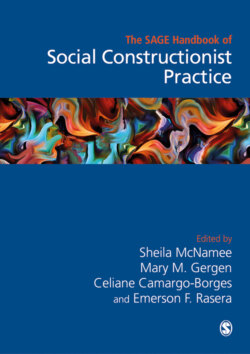Читать книгу The Sage Handbook of Social Constructionist Practice - Группа авторов - Страница 12
На сайте Литреса книга снята с продажи.
1 Constructionist Theory and the Blossoming of Practice
ОглавлениеKenneth J. Gergen
The stunning growth of the natural sciences in the 20th century was accompanied by an unbridled optimism. It was just such optimism that also sparked the development of the ‘social sciences’. If inquiry in the natural sciences could lead to the eradication of disease, the harnessing of energy, air flight, and powerful weaponry, one could only imagine the potentials of the social sciences. Could we not cure mental illness, ensure effective education, create profitable organizations, eradicate war, and more? The logic for realizing such societal gains was based on a positivist model of science in which knowledge is established in the basic or pure sciences – such as chemistry, biology, and physics – and then made available to society for broad application. With increased knowledge of the brain, for example, new practices would be anticipated in medicine, education, aviation, athletics, and so on. Thus, in the social sciences, disciplines such as psychology, economics, and sociology could hope to generate fundamental knowledge of broad applicability. Little now remains of the early optimism. Neither the voluminous theoretical offerings nor the staggering accumulation of research findings in the social sciences have contributed significantly to societal well-being.
During the waning years of the 20th century, a range of conversations across the academic community began to challenge positivist assumptions about the nature of scientific truth, objectivity, and value-neutral knowledge. These dialogues ultimately gave rise to what is now characterized as a social constructionist (or constructivist)1 orientation to knowledge. As deliberations on this orientation have matured and made their way into circles of professional practice, the results have been astonishing. A spirited wave of innovation has swept across the professions, across many regions of the world, and its force has continued to the present. Early innovations in fields of therapy, education, and organizational development were soon followed by new practices in social work, law, counseling, cartography, practical theology, community building, and conflict reduction. These were followed by developments in social justice, healthcare, and welfare programs. Also noticeable were the ways in which innovations carried across borders of practice. New practices in law drew from developments in therapy; new welfare programs found resources in organizational development, and so on. Further, energizing dialogues between the communities of ‘knowledge makers’ and ‘practitioners’ emerged. The concept of ‘scholar practitioners’ is now a commonplace phrase.
How are we to understand this mutually enriching relationship between social constructionist ideas and the flowering of innovative practices? What is it about the constructionist dialogues that practitioners have found so inspiring? Can we anticipate a continuing harvest of such magnitude; are there forces that threaten a sustained prosperity? It is to just such questions that the remainder of this chapter is devoted.
